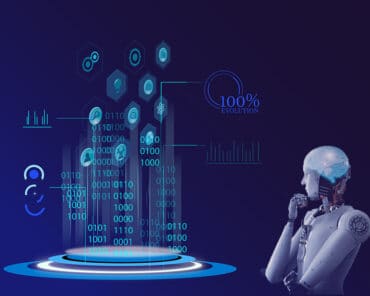
While AI and machine learning can help, front-line employees are ultimately the ones who can deliver that empathy and care customers desire today.
Human-centered design — listening carefully to customers and tailoring products and services to fit their habits and preferences — is an increasingly popular theme not only among leaders in financial services but in other industry sectors, as well.
Digital products are increasingly leveraging artificial intelligence (AI) to improve user experiences by making them faster, increasingly guided, and more intelligently interactive. AI augments the user/human experience, and creating a symbiotic relationship between the human and the application relies heavily on the AI portion being designed around the human’s preferences, habits, and behaviors…not the other way around. A data-centric approach to understanding customer and employee needs is critical for informing truly human-centered design.
The Value of Customer and Workforce Experience
McKinsey research shows improving customer experience resulted in increased sales revenues of 2% to 7% and increased profitability of 1% to 2%. Going a step further, those companies that prioritize workforce experience (WX) alongside customer experience (CX) make it easy for their teams to create the types of memorable customer experiences that improve both initial conversion as well as retention. By putting both customers and employees at the center of the design of their AI-driven products, the resultant experience drives not only top-line growth but also provides a distinct advantage when attracting and retaining the best talent for your company.
To place customers at the center of strategy, financial services executives first need to understand the end-to-end customer journey. This journey begins with decisions that are made before the purchase, throughout the actual purchase process, and in the days and weeks that follow. Companies providing their account executives with specific, actionable, data-driven insights about a prospect leads to more tailored offerings and, resultantly, a boost to sales conversions.
Converting the prospect into a customer is only the beginning of their journeys. While the adage that it costs 5x as much to acquire a new customer as it does to retain one may no longer be as relevant as it once was, the most profitable companies continuously engage with customers and create value that the customer can easily capture. This increases the probability that they’ll retain/renew those customers and optimize customer lifetime value (CLV). During that lifetime, executives must closely examine their employees’ workflows and processes to ensure that it’s easy for them to guide customers at key decision points and interactions, including ongoing relationship and business development and customer support interactions. Focusing ruthlessly on the customer without adequately empowering your workforce to deliver customer experiences with ease isn’t sustainable, and customers will notice.
See also: Three Strategies for Building a Data-Driven Company
Why Human-centered Design is Important to Customers
Deploying solutions built using human-centered design is critical in my industry – workers’ compensation insurance. This is especially true because oftentimes, our customer is not the policyholder — the one who purchases the insurance policy — but instead, an injured worker who needs to file a claim.
When a worker gets hurt on the job, they’re vulnerable, physically hurt, and usually don’t know how to navigate the claims process. It’s imperative that the claims adjuster guides the injured worker through the process with care and empathy. Claims adjusters are empowered to provide this personalized experience when they can focus on the person — the injured worker — and not on searching for data and insights.
Insurance carriers are more frequently utilizing machine learning models that enable many decisions to be automated, freeing claims adjusters to focus on supporting their customers while also directing their attention toward more complicated facets of claims management. The wider adoption of analytical tools powered by artificial intelligence and machine learning allows carriers to better understand the needs and desires of their customers in more real-time, sometimes as quickly as new information about the injury and circumstances are provided.
While machine learning models produce important, tailored insights, it is also critical to be thoughtful about how to deliver insights so that users, such as claims adjusters, can actually leverage them. Employees shouldn’t have to guess where they can find these insights, and if it’s not easy, some simply won’t bother. This is at the core of why considering the human at the center of the design of AI is so critical. Ease of use is paramount to adoption, which, in turn, creates that augmented user experience that enables the type of engagement with injured workers that leads to better outcomes.
This symbiosis can accelerate the claims process, which not only helps the injured worker receive their benefits sooner but it may help them get back to work earlier by ensuring they’re getting appropriate, timely medical care. Taking a human-centered design approach to machine learning results in empowered and efficient workers’ compensation claims adjusters who can provide a personalized, compassionate care experience. Delivering this human-centered design at scale is also what develops a customer’s bond with a brand.
Leading From Experience
Throughout my career, I’ve led teams that deliver analytical insights that put humans at the center of their design, helping them “automate the ordinary so they can focus on the extraordinary.” Customers across all industries now expect these easier, increasingly guided experiences. In industries that focus on customers’ well-being (such as health, financial well-being, and insurance), these experiences matter more than just a little bit.
This is a clarion call to chief data analytics officers and the talented practitioners within their organizations to design analytical insight solutions that focus on the “care” component of customer experience. Machine learning and AI solutions are complicated and difficult to build, but those solutions must be easy to use, especially in those industries where the customers are really counting on you for life’s important decisions. Your front-line employees, not AI or analytics models, are ultimately the ones who can deliver that empathy and care, so you must design with their ease in mind, too. Always start with people. Then, and only then, should you align it to business viability and investigate technical feasibility. Always put the human – the customer, the injured worker, your employees – at the center of everything you do.






























